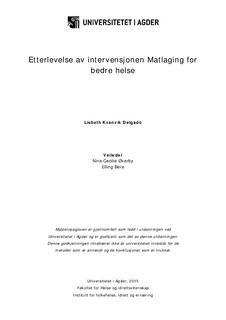| dc.description.abstract | Background and aim: This Master Thesis is a part of a collective work, entitled: Cooking for improved health intervention. The purpose of the main-study was to investigate whether we can get the over weighted participants (BMI>25) to make their own breads and cook dinner from scratch, and whether it will have an influence on health measures- BMI, waist circumference, weight and activity.
This thesis explores to which extent the participants follow the intervention and make more bread and cook more dinner from scratch during the intervention period at approximately four weeks.
Method: Frequency questionnaire was used to measure whether participants baked bread and cooked dinner from scratch more often immediately after the intervention. Participants filled out the questionnaire before and after the intervention.
Throughout the intervention period, food diaries were used to determine the adherence of the participants to intervention directives, namely to bake bread and cook dinner from scratch during the intervention period.
Result: Based on frequency questionnaire we found a significant increase in baking bread amounted to a difference of 2 times a week. Before the intervention the participants baked bread 0.6 times weekly, however after the intervention participants baked 2.5 times weekly.
According to the food diary, participants baked bread on average 0.8 times weekly during the intervention period.
Before the intervention, the participants cooked dinner from scratch 3.4 times weekly and 3.9 times weekly, after intervention according to frequency questionnaire, which represents a slight increase of 0.5 times a week.
According to food diaries, the participants cooked dinner from scratch on average 3.1 times a week.
Side 5
Based on the frequency questionnaire, vegetable cutting had a slight increase of 0.5 times a week. Before intervention, participants were cutting vegetables on an average of 3.8 times weekly. After intervention, the participants were cutting vegetables on an average of 4.2 times weekly.
Food diaries missed parameters to measure vegetable cutting.
Conclusion: The fact that we got a significant increase in bread baking, indicate that the aim of getting participants to bake more bread has been achieved. According to cooking dinner from scratch and vegetable cutting measure, the increase was too small to be significant and the aim of getting participants to cook more dinner from scratch was thus not reached.
Further studies on adherence associated with cooking interventions and follow-up studies on the effects of those interventions on the long term basis, are needed. | nb_NO |
